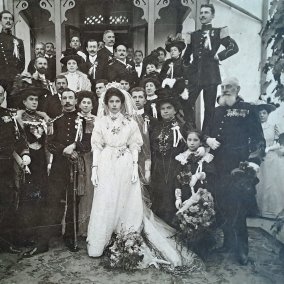On Sunday, November 30, 2025, the 1st Advent, an artist talk with Peter Jacobi will take place in the Transylvanian Museum from 2 pm on the occasion of his 90th birthday.
All interested parties are cordially invited to the event! Admission is free on this day!
The sculptor and photographer Peter Jacobi is one of the most important contemporary artists of Transylvanian origin. From 1971 to 1998 he was a professor at the University of Design in Pforzheim and designed, among other things, the national Holocaust memorial in Bucharest, which was inaugurated in 2009.
In the cabinet exhibition "Bilderwelten // Weltenbilder", the Transylvanian Museum, in cooperation with the Transylvanian Institute at the University of Heidelberg, is showing an exemplary selection of his important photo collection in his honor.
For more than 50 years, the artistic preoccupation with the culture of remembrance has been a guiding theme in the work of the artist, who was born in 1935. Over the decades, Peter Jacobi has therefore built up a unique archive of historical photographs, large parts of which he donated to the Transylvanian Institute and the Transylvanian Museum in 2024.
The multifaceted collection of private, documentary, art and press photographs spans a wide range from the beginnings of photography in the mid-19th century to the 1980s. The subjects covered are just as wide-ranging, from family portraits to cityscapes, ethnological photographs and documentary photographs of historically significant events. We encounter Mongolian dancers and communist functionaries as well as members of the Romanian royal family and intellectual greats such as the physicist Hermann Oberth. The oldest photograph shows a married couple from the 1860s. In addition to this, there are several wedding photos documenting the changes in fashion and customs up to the 1930s. But the exhibition also includes architectural photographs that illustrate the change in urban development from International Modernism to the socialist housing of the 1960s in Romania, as well as press photographs from the First World War. Geographically, the collection focuses on works with Romanian or Transylvanian references. However, there are also press photographs from all over the world and portraits from studios outside Transylvania, for example from Chișinău (now Moldova) or Odessa (now Ukraine). The photographs thus also bear witness to the quality of long-gone photo studios in Transylvania and far beyond.
The exhibition itself can be seen until March 15, 2026.
All interested parties are cordially invited to the event! Admission is free on this day!
The sculptor and photographer Peter Jacobi is one of the most important contemporary artists of Transylvanian origin. From 1971 to 1998 he was a professor at the University of Design in Pforzheim and designed, among other things, the national Holocaust memorial in Bucharest, which was inaugurated in 2009.
In the cabinet exhibition "Bilderwelten // Weltenbilder", the Transylvanian Museum, in cooperation with the Transylvanian Institute at the University of Heidelberg, is showing an exemplary selection of his important photo collection in his honor.
For more than 50 years, the artistic preoccupation with the culture of remembrance has been a guiding theme in the work of the artist, who was born in 1935. Over the decades, Peter Jacobi has therefore built up a unique archive of historical photographs, large parts of which he donated to the Transylvanian Institute and the Transylvanian Museum in 2024.
The multifaceted collection of private, documentary, art and press photographs spans a wide range from the beginnings of photography in the mid-19th century to the 1980s. The subjects covered are just as wide-ranging, from family portraits to cityscapes, ethnological photographs and documentary photographs of historically significant events. We encounter Mongolian dancers and communist functionaries as well as members of the Romanian royal family and intellectual greats such as the physicist Hermann Oberth. The oldest photograph shows a married couple from the 1860s. In addition to this, there are several wedding photos documenting the changes in fashion and customs up to the 1930s. But the exhibition also includes architectural photographs that illustrate the change in urban development from International Modernism to the socialist housing of the 1960s in Romania, as well as press photographs from the First World War. Geographically, the collection focuses on works with Romanian or Transylvanian references. However, there are also press photographs from all over the world and portraits from studios outside Transylvania, for example from Chișinău (now Moldova) or Odessa (now Ukraine). The photographs thus also bear witness to the quality of long-gone photo studios in Transylvania and far beyond.
The exhibition itself can be seen until March 15, 2026.
This text was translated by an AI.



